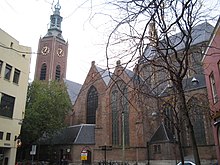Grote Kerk (The Hague)
The Grote of Sint-Jacobskerk ( German Great or St. Jakobus Church ), consecrated to St. James before the Reformation , is the city church of The Hague and one of the most important works of brick Gothic in the Netherlands.
history
The oldest part of the Gothic hall church , dating from the 14th century , was badly damaged in a fire in 1539 .
The 93 m high church tower, built in 1420 , stands out due to its hexagonal shape, which is unique in the Netherlands. After the church burned down, the tower, which was also used as a military observation post, was rebuilt in the Renaissance style. In 1861 it was given a neo-Gothic spire. This part of the tower was affectionately known as sleepyhead by the Hague residents , but was removed during the 1951 renovation .
The German occupiers removed the carillon in July 1941 , but since the largest bell, called Jhezus , did not fit through the small openings in the tower, it was retained in the church. In 1959 one of the largest carillon in the Netherlands with 51 bells was added.
Most of the wedding and christening celebrations of the royal family took place in the Groten Kerk. Since a thorough renovation was completed in 1987 , the church has now been used as a location for exhibitions, fairs and festive events.
Furnishing
In the beautifully vaulted nave of the Grote Kerk with a high, light choir there are several tombs and tombstones, including those of the poet and statesman Constantijn Huygens († 1687 ) and his son, the physicist and astronomer Christiaan Huygens († 1695 ) on the rear choir wall .
Also noteworthy are the wood-carved pulpit from 1550 , the coats of arms of the knights from the Order of the Golden Fleece and the large organ from 1971 as well as the windows in the choir and in the north transept.
organ
The large organ was built in 1971 by the organ building company Metzler (Dietikon). The purely mechanical instrument has 50 stops on three manuals and a pedal .
|
|
|
|
|||||||||||||||||||||||||||||||||||||||||||||||||||||||||||||||||||||||||||||||||||||||||||||||||||||||||||||||
- Coupling : II / I, III / I, I / P, II / P
See also
Web links
- Church website (Dutch)
- Great Church In: denhaag.com (German)
Individual evidence
- ↑ More information on the history and disposition of the great organ
Coordinates: 52 ° 4 ′ 38.4 " N , 4 ° 18 ′ 25.6" E



